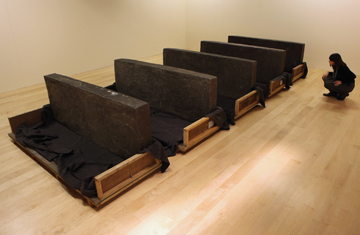
This piece by Santiago Sierra is made of human waste and is on display at "Dirt: The Filthy Reality of Everyday Life," which runs through August in London
Talk about dishing the dirt. A new exhibition in London lets visitors in on the dirtiest of secrets: most everything we consider filthy — from dust to excrement to bacteria to rubbish to soil — is also essential to human existence.
Our paradoxical relationship with all things gross and grimy is the central theme of "Dirt: The Filthy Reality of Everyday Life," which runs through Aug. 31 at the Wellcome Collection, a museum operated by the Wellcome Trust health care charity. Using artifacts, documents, drawings, photos, videos and art installations, "Dirt" takes a down-and-dirty look at the social, economic and public-health aspects of life's detritus, across history and around the world. Moreover, the trust's companion Dirt Season extends the effort beyond the exhibition by offering a variety of filth-laden online games and events around the U.K. through September. "We are both fascinated with and repulsed by dirt," explains James Peto, senior curator. "Dirt really is everywhere, and that's not necessarily a bad thing. So, yes, it is a bit of a celebration of dirt."
Consider some of dirt's more salubrious facets: we grow food in soil (sometimes fertilized with manure), some strains of bacteria are vital to life, and there's growing scientific evidence that superscrubbing our homes with germ-killing cleansers might make us less healthy by weakening our immune systems.
Still, "Dirt" doesn't try to sanitize the harmful, often deadly, effects of the contaminants that surround us. The exhibition has a display about Broad Street in London's Soho district, where 500 people died of cholera during a 10-day period in 1854 amid a yearlong epidemic in the city. At the time, it was widely considered that a foul miasma caused the disease. Physician John Snow correctly determined that the true cause was fetid water, but it took years before his theory was widely accepted. His "ghost map," which charted the disease's deadly march through Soho, is among the artifacts on display. Cholera victims suffer severe vomiting and diarrhea, which eventually turns to a milky liquid — at the time euphemistically called rice water. A vial of that is on show as well.
Scavenging was an occupation of sorts in 19th century London, and some of the tools of the city's sewer hunters are displayed. Ragpickers collected old clothes, night men emptied cesspools and pure finders scooped up dog poop, which was purchased by tanneries. "Dirt" also grimly documents with graphic photographs how even today in India around a million Dalits, or untouchables, work for pennies a day to hand-clean dry latrines. The exhibit includes a sculpture created by controversial Spanish artist Santiago Sierra to draw attention to the Dalits' plight; it consists mainly of five large dark gray slabs fashioned from the wastes that they collect.
"Dirt" also dives into cleanliness and sanitation, with displays highlighting the 17th century Dutch city of Delft, renowned at the time for its soap-loving ways, as well as Joseph Lister's pioneering of antiseptic surgery at the Glasgow Royal Infirmary in 1881. That hospital was so dingy that patients admitted with a broken bone stood a 90% chance of amputation — the better to avoid a life-threatening infection.
If the exhibition isn't enough to satisfy those curious about crud, the Wellcome Trust's accompanying Dirt Season offers plenty of other ways to enjoy some filthy fun. Anyone with an iPhone or iPad can download Filth Fair, a word-puzzle game so coarse it had to be toned down for the iTunes app store. From late May to early June, the Eden Project, an eco-center in Cornwall, will feature activities and lessons for youngsters that focus on feces, including a history of toilets and beneficial uses for excrement. "We wanted to do some really gross stuff for the kids," says Amy Sanders, head of special projects for the trust, who coordinated the season. Other events are planned for three musical festivals — Glastonbury, Bestival on the Isle of Wight and Secret Garden Party in East Anglia. At the latter, a banquet featuring foods made from dirt — including an edible mud pie that's not a chocolate lover's delight — is on the menu. And whether at the exhibition or one of the events, visitors can pick up scratch-and-sniff cards that are coordinated to an online video and reveal the odors of four of history's stinkiest locales, including an 18th century Parisian tannery. Putrid doesn't even begin to describe it.
Our fascination with the unclean is not new. Middle-class Victorians took "slum tours" to get a firsthand look at urban squalor — some for philanthropic reasons, others for titillation. Today, most tourists who head for "Dirt" are probably hoping to learn something new about the decidedly grubby history of the human race and, with London awash in the sanitized frivolity of the royal wedding, probably to have some dirty fun too.
